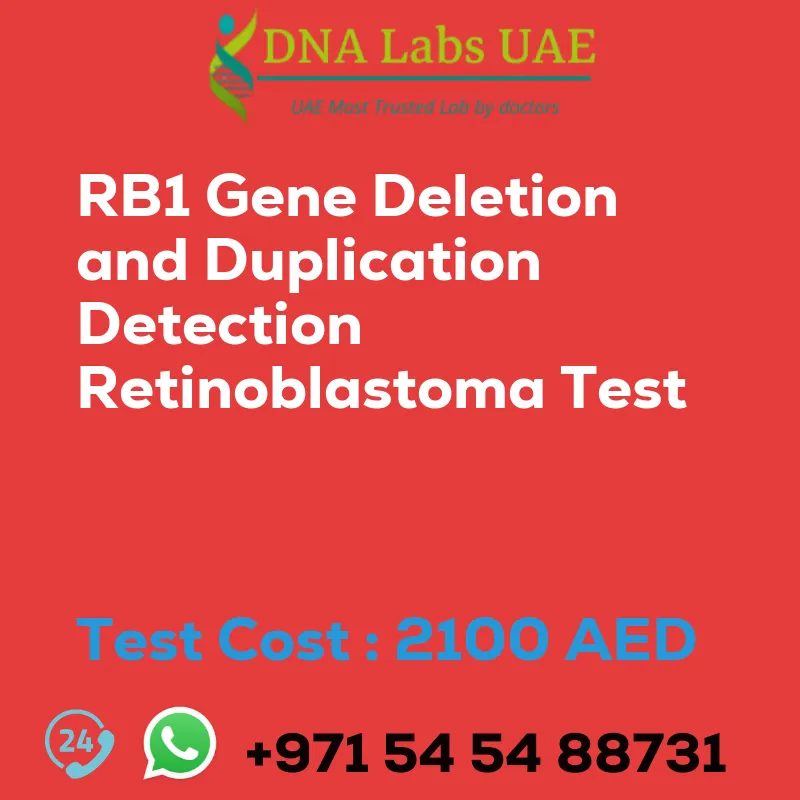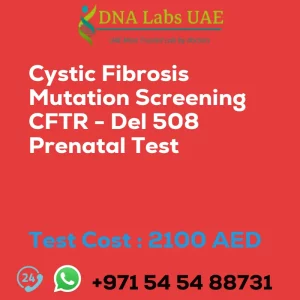RB1 Gene Deletion and Duplication Detection Retinoblastoma Test
At DNA Labs UAE, we offer the RB1 gene deletion and duplication detection test for retinoblastoma. This rare type of eye cancer primarily affects young children and early diagnosis is crucial for effective treatment.
Test Details
The RB1 gene is a tumor suppressor gene that helps regulate cell growth and division. Mutations or alterations in this gene can lead to the development of retinoblastoma. Our RB1 gene deletion and duplication detection test utilizes various methods to accurately diagnose this condition:
- Fluorescence in situ hybridization (FISH): This technique uses fluorescent probes to bind to specific regions of the RB1 gene, allowing for the visualization of any deletions or duplications in the gene.
- Multiplex ligation-dependent probe amplification (MLPA): MLPA detects copy number changes in the RB1 gene by using specific probes that bind to different regions of the gene. Amplification patterns can indicate deletions or duplications.
- Array comparative genomic hybridization (aCGH): This high-resolution technique can detect copy number changes across the entire genome, including the RB1 gene. It compares the patient’s DNA with a reference DNA sample to identify any deletions or duplications.
- Next-generation sequencing (NGS): NGS is a powerful technique that can detect RB1 gene alterations, including deletions and duplications, by sequencing the entire gene or specific regions of interest. It provides a comprehensive analysis of the RB1 gene and can identify other genetic changes associated with retinoblastoma.
These techniques require a sample of tumor tissue obtained through a biopsy or surgical removal of the tumor. The RB1 gene deletion and duplication detection test provides valuable information that can guide treatment decisions and offer insights into the prognosis of retinoblastoma patients.
Test Name: RB1 Gene Deletion and Duplication Detection Retinoblastoma Test
- Components: EDTA Vacutainer (2ml)
- Price: 2100.0 AED
- Sample Condition: Peripheral blood
- Report Delivery: 7-10 days
- Method: MLPA
- Test Type: Genetics
- Doctor: Oncology
- Test Department:
Pre Test Information
A doctor’s prescription is required for RB1 gene deletion and duplication detection (Retinoblastoma) test. Please note that the prescription is not applicable for surgery and pregnancy cases or individuals planning to travel abroad.
Early detection of RB1 gene deletion and duplication is crucial for effective treatment of retinoblastoma. If you suspect any symptoms or have concerns, consult with a healthcare professional who can provide the necessary guidance and prescribe the appropriate tests.
Don’t delay in getting the RB1 gene deletion and duplication detection test if you suspect retinoblastoma. Early diagnosis can significantly improve the chances of successful treatment and better outcomes for young children.
| Test Name | RB1 gene deletion and duplication detection Retinoblastoma Test |
|---|---|
| Components | EDTA Vacutainer (2ml) |
| Price | 2100.0 AED |
| Sample Condition | Peripheral blood |
| Report Delivery | 7-10 days |
| Method | MLPA |
| Test type | Genetics |
| Doctor | Oncology |
| Test Department: | |
| Pre Test Information | RB1 gene deletion & duplication detection (Retinoblastoma) can be done with a Doctors prescription. Prescription is not applicable for surgery and pregnancy cases or people planing to travel abroad. |
| Test Details |
RB1 gene deletion and duplication detection is an important aspect of diagnosing retinoblastoma, a rare type of eye cancer that primarily affects young children. The RB1 gene is a tumor suppressor gene that helps regulate cell growth and division. Mutations or alterations in this gene can lead to the development of retinoblastoma. There are various methods used to detect RB1 gene deletion and duplication, including: 1. Fluorescence in situ hybridization (FISH): FISH is a technique that uses fluorescent probes to bind to specific regions of the RB1 gene. This allows for the visualization of any deletions or duplications in the gene. 2. Multiplex ligation-dependent probe amplification (MLPA): MLPA is a method that allows for the detection of copy number changes in the RB1 gene. It uses specific probes that bind to different regions of the gene, and the resulting amplification patterns can indicate deletions or duplications. 3. Array comparative genomic hybridization (aCGH): aCGH is a high-resolution technique that can detect copy number changes across the entire genome, including the RB1 gene. It compares the DNA from a patient with a reference DNA sample and identifies any deletions or duplications. 4. Next-generation sequencing (NGS): NGS is a powerful technique that can detect RB1 gene alterations, including deletions and duplications, by sequencing the entire gene or specific regions of interest. It provides a comprehensive analysis of the RB1 gene and can identify other genetic changes associated with retinoblastoma. These techniques are typically performed on a sample of tumor tissue obtained through a biopsy or surgical removal of the tumor. The results of RB1 gene deletion and duplication detection can help guide treatment decisions and provide valuable information about the prognosis of retinoblastoma patients. |







